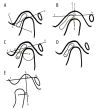Magnetic Resonance Imaging (MRI) Evaluation for Anterior Disc Displacement of the Temporomandibular Joint
- PMID: 28176754
- PMCID: PMC5312235
- DOI: 10.12659/msm.899230
Magnetic Resonance Imaging (MRI) Evaluation for Anterior Disc Displacement of the Temporomandibular Joint
Abstract
BACKGROUND Magnetic resonance imaging (MRI) is the criterion standard imaging technique for visualization of the temporomandibular joint (TMJ) region, and is currently considered the optimum modality for comprehensive evaluation in patients with temporomandibular joint disorder (TMD). This study was aimed at finding the value of MRI in pre-clinical diagnosis of TMJ disc displacement. MATERIAL AND METHODS Patients primarily diagnosed as having anterior disc displacement by clinical symptoms and X-ray were selected in the present study. MRI was used to evaluate surrounding anatomical structures and position, as well as morphological and signal intensity change between patients and normal controls. RESULTS Posterior band position was significantly different between the patient group and control group. At the maximum opened-mouth position, the location of disc intermediate zone returned to normal. At closed-mouth position, the thickness of anterior and middle, but not posterior, band increased. The motion range of the condyle in the anterior disc displacement without reduction (ADDWR) patient group was significantly less than the value in the anterior disc displacement with reduction (ADDR) patient group and the control group. Whether at closed-mouth position or maximum opened-mouth position, the exudate volume in the patient group was greater than in the normal group. CONCLUSIONS MRI can be successfully used to evaluate multiple morphological changes at different mouth positions of normal volunteers and patients. The disc-condyle relationship can serve as an important indicator in assessing anterior disc displacement, and can be used to distinguish disc displacement with or without reduction.
Figures



References
-
- Manfredini D, Guarda-Nardini L, Winocur E, et al. Research diagnostic criteria for temporomandibular disorders: A systematic review of axis I epidemiologic findings. Oral Surg Oral Med Oral Pathol Oral Radiol Endod. 2011;112:453–62. - PubMed
-
- Westesson PL. Reliability and validity of imaging diagnosis of temporomandibular joint disorder. Adv Dent Res. 1993;7:137–51. - PubMed
-
- Nogami S, Takahashi T, Ariyoshi W, et al. Increased levels of interleukin-6 in synovial lavage fluid from patients with mandibular condyle fractures: Correlation with magnetic resonance evidence of joint effusion. J Oral Maxillofac Surg. 2013;71:1050–58. - PubMed
MeSH terms
LinkOut - more resources
Full Text Sources
Medical

